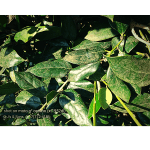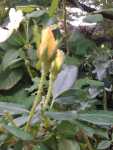Sooty Mold is a gardener’s nightmare if it goes unnoticed for too long. Black Sooty Mold is a plant fungus that can even move off the plant and spread to mulch and gravel around plants. Insects both pests and pollinators can inadvertently spread it to other plants.

Sooty Mold Plant Description
As the name Sooty Mold implies it appears dark brown or black in spots often resembling a powder on plant leaves and stems. This plant fungus can be gently scraped off to show the healthy plant underneath if caught in the early stages.

Plants Commonly Affected By Black Sooty Mold
Healthy plants are less likely to be infected. However, stress caused by replanting, drought, too much rain, or poor soil conditions may leave a plant vulnerable. Certain plants are more likely to get Sooty Mold. It’s always a great idea to ask your landscaper or local garden center about what kinds of plant fungus or disease any new plant you purchase may be prone to.

- Crape Myrtle
- Roses
- Azaleas
- Gardenias
- Evergreens boxwood, yew, holly ect.
If Left Untreated
If the plant fungus is not caught in time and allowed to grow it will block out sunlight and prevent the plant from properly photosynthesizing. This stunts plant growth.
Tips For Preventing Sooty Mildew and Other Plant Fungus
Insects are the leading cause of plant fungus. Checking plants for Pests is the best place to start when fungus or other plant illness occurs.

- Aphids
- Whiteflies
- Wooly Aphids
- Ants
- Spider mites
- Mealybugs
Many pest insects suck the sap the undigested sap left over is called honeydew. The pest also leaves behind a small hole and like when people get a cut the wound is open to infection. The honeydew that is left in the open wound attracts sooty mold, another fungus, and disease. Pollinators and other insects then inadvertently carry the fungus from one plant to another. Cross-contamination.
If Pests Are The Culprit
If you find that aphids or other pests are responsible they need to be removed or treated as soon as possible.
- Pruning if the pest is only on a few leaves or a branch
- Introduce nature predators such as lacewings or ladybugs
- Horticulture or Neem Oil may be sprayed on the plants
- A mixture of 1 part Hydrogen peroxide to 10 part water in a spray bottle
- Dish soap and water in a spray bottle
Companion gardening is another great way to prevent unwanted pests. Garlic, onions, and mint added to a garden help deter many pests.
Other plants that have a higher tolerance to aphids and other sap-sucking pests can also be planted in another area of the landscape to attract unwanted guests from prized plants.
- Cosmos
- Zinnias
- Dahlias
- Aster

The plants listed above are great attractors to keep Crape Myrtle, Roses, and other plants safe. There are also many widely available products on the market including copper fungicide to deter and kill unwanted plant pests. Be sure to always read the label carefully and apply as directed. Don’t forget that anytime you spray a plant with oil or even a soap mixture to make sure it is not in direct sunlight so the plant does not get burnt.
Periodically recheck plants for fungus and pests, they both always come back when you least expect it and think you’re in the all-clear. Be sure to check the area surrounding the plant too sooty mold loves to hang out in the gravel and mulch around plants.